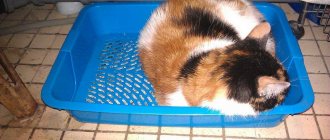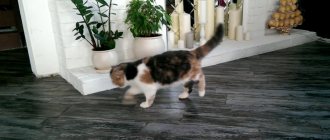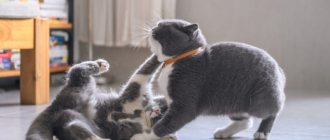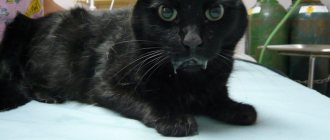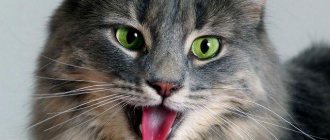When a cat suddenly starts to tremble, it alarms and sometimes even frightens the owners. This phenomenon is called tremor, it is caused by involuntary contraction of one or all muscle groups. There are physiological and pathological reasons for its occurrence, which can only be accurately determined by a veterinary specialist. But in order to provide timely help to the pet, the owner must know the reasons why the cat is trembling.
What is tremor in cats
Tremor in cats is a convulsive contraction of the muscles of the animal’s body, which is visually expressed in the form of small tremors. Sometimes the cat's whole body trembles, but certain parts of it may also shake. Involuntary muscle contraction, called tremor, can also occur in a state of complete rest, indicating maximum relaxation of all muscle groups. However, trembling often indicates that the cat has serious health problems and the animal requires urgent treatment.
Important! If long-haired cats shake with small tremors, then you can only feel it if you put your hand on the animal. But sometimes the tremor is clearly visible and is accompanied by other alarming symptoms.
About meningoencephalitis
Non-purulent meningoencephalitis is most often diagnosed by doctors in a situation where a cat twitches in its sleep. The difference between this disease and ordinary encephalitis and classic meningitis is the absence of accumulations of pus inside the skull. The pathogenesis itself combines some processes characteristic of both diseases. This disease is an inflammation of the membranes of the brain and itself. It occurs most often in the form of complications and consequences of such ailments as:
- viral infections;
- hepatitis;
- leptospirosis;
- plague;
- ascariasis and mycosis.
In addition, the disease develops after bruises, various injuries to the skull and spine, and prolonged sepsis. Cramps during sleep are one of the earliest symptoms of this disease. But if you consult a doctor, your pet’s treatment will be successful and quickly enough.
Physiological causes of trembling
Sometimes a cat trembles due to external factors such as a sudden change or decrease in the temperature of the surrounding area. Physiological factors of tremor also include stress, sexual arousal, deep sleep or some reflex processes in the animal’s body.
Cold
You will often notice that your cat will shiver after swimming or spending a long time outside on a cold day. This tremor is a mechanism of thermoregulation and does not allow the animal to freeze for a long period of time.
Pampered domestic cats get chills even with a slight drop in ambient temperature, while a pet hardened by frequent walks can stay outside for a long time, even in severe frosts. Owners should take into account such individual characteristics of their cats’ bodies to determine the duration of the walk, since hypothermia easily leads to the development of colds and inflammatory pathologies.
Important! Even if the room is warm, the animal's fur must be thoroughly dried after bathing. It is also important to ensure there are no drafts and not to allow the cat to lie on a cold surface.
Emotional excitement
The cat may tremble as if it were cold when there is strong emotional arousal, positive or negative. Both during fear and during times of great joy, a large amount of certain hormones enter the animal’s bloodstream, which provoke muscle tremors.
By this sign you can determine the mood of your pet. For example, when nervous, a cat shakes as if frozen, arches its back, hisses or meows loudly. Sometimes the readiness to attack is expressed only in the shaking of the tail raised up. At the same time, sitting on the lap of its beloved owner, the animal may tremble slightly and purr with pleasure.
Sexual arousal
During the period of sexual heat, all the senses of male cats become more acute. In the absence of a sexual partner, animals are constantly nervous, strive to get out of the house, and may show aggression or excessive intrusiveness. The cat is shaking from the powerful release of sex hormones into the blood. This condition leads not only to mental disorders of the animal, but also provokes the development of malignant tumors of the reproductive organs and mammary glands. Therefore, the most humane way to get rid of the suffering of cats and female cats that do not take part in breeding is castration.
Other reasons
Some cats may experience tremors as a reflex after eating food. It is especially common to notice how a well-fed kitten trembles in its sleep and does not show signs of anxiety.
Sometimes owners have a question about why the cat trembles when he sleeps. Experts even have a special term “sleepy tremor,” which indicates maximum relaxation of all muscles.
A cat may also shiver in its sleep when sleeping indoors with low air temperatures. This is indicated by the animal’s posture - the cat curls up into a tight ball, “burying” its nose as deeply as possible into the fur or under the paw.
Important! If the cat is shaking in its sleep, trying in vain to warm its frozen limbs, but at the same time the room is quite comfortable and warm, then you should measure the pet’s temperature. Her sharp decline indicates a very serious pathology that is life-threatening.
Poor and restless sleep, which is accompanied by periodic twitching of the limbs and tremors in the body, may be a consequence of stress or prolonged physical exertion. Most often, owners observe this condition in their pet after he “defended his rights” to a female during the period of sexual heat.
“Senile tremor” can also be considered normal. Poor circulation and innervation is the reason why an elderly cat shakes when lying or sitting in a relaxed state.
What is the difference?
It is quite difficult to independently determine the difference between neurosomatic twitching and symptoms of an internal disease. The likelihood of an error is very high, therefore, if twitching of the body or limbs of a cat occurs regularly during rest, it is necessary to examine the animal.
The defining difference in the causes of twitching is considered to be the presence of a cramp. This means not only twisting of the limbs or body, in which the cat wakes up and screams, but also a slight hardening of the muscle fibers. The manifestation of emotional experiences, as a rule, is not accompanied by the appearance of stiffness in the muscles. That is, if a cat is upset and “runs around in its sleep,” its body and paws will be soft.
However, the causes of twitching are often mixed, since the sick animal perceives everything around it quite acutely.
Pathological causes of tremor
The reason why the cat is trembling as if he is cold, although he is at home in comfortable conditions, may be pathological factors. In this case, tremor is often accompanied by the following clinical symptoms:
- photophobia;
- inactivity and lethargy;
- aggression;
- pain syndrome;
- increased body temperature;
- diarrhea or constipation;
- vomit;
- purulent discharge from the nasal cavity or eyes;
- impaired coordination of movements.
Often, the presence of pathology in a cat is indicated by trembling of individual parts of the body or muscle groups, when only the head, front or hind limbs shake.
Important! Tremor must be distinguished from convulsions, which are always accompanied by pain. In kittens up to 5-6 months of age, when their central nervous system is intensively developing, seizures can be physiological in nature. In other cases, seizures indicate the presence of serious disorders of brain function caused by infectious or traumatic factors.
There are many pathological reasons why kittens and adults tremble.
A deficiency of calcium and B vitamins in the body provokes degenerative processes in muscle tissue in cats.
The reason that the kitten is trembling may be infectious rhinotracheitis. In addition to tremor, this disease is accompanied by cough, purulent discharge from the eyes and nose, a significant increase in body temperature and digestive disorders.
With the development of helminthic infestations, when helminths clog the pet's intestines and release a huge amount of toxic products of their vital activity, the kitten experiences symptoms of intoxication, it becomes lethargic and trembles all over its body.
The body's response to the introduction of general anesthesia. If the cat shakes for more than 6 hours after surgery, this may indicate the development of internal bleeding. In this case, urgent medical intervention is necessary.
Body tremors in cats are provoked by acute inflammatory processes in the organs of the genitourinary system and attacks of urolithiasis.
Otitis media, caused by ear mites or other factors, leads to frequent head twitching. The cat scratches the sore ear, hits it, tilts its head towards the affected organ. As a result, scratches and hematomas appear in the ear area. Lack of treatment leads to inflammation spreading to the inner ear and meninges, which provokes death.
During acute liver failure, the cat develops vomiting and diarrhea; at the initial stage, it trembles slightly, and at the stage of failure of the affected organ, it trembles all over.
Head tremor may indicate traumatic brain injury, encephalitis, cerebellar lesions, or drug overdose.
If a kitten walks poorly and his whole body shakes, this may indicate spinal column injuries caused by congenital pathologies, compression or bruises. In adult cats, such symptoms are the result not only of injury, but also the development of tumors or deformation of the intervertebral discs.
If a kitten suddenly becomes lethargic, begins to tremble, first slightly, and then with increasing amplitude, then such tremors and lethargy most often indicate poisoning. If the baby is not taken to the clinic, he will develop seizures and die.
The cause of tremor may be borreliosis, which occurs after a tick bite. The insidiousness of the disease lies in its long latent period, when clinical signs may appear several months after infection.
Tremor combined with lethargy may be one of the signs of toxoplasmosis in cats.
If a kitten walks poorly, shakes, spins in place, or is poorly oriented in space, this may indicate that he has such a serious congenital pathology as hydrocephalus.
Tremors of the limbs, turning into convulsions, can occur in a cat during childbirth or within a week after it. This phenomenon is called eclampsia. It indicates an acute lack of calcium in the animal’s body. If left untreated, your cat will develop seizures, which can be fatal.
A kitten's active sleep is not a reason to worry
Most of the speculation surrounding the concern comes from kitten owners. We dare to assure you that if your cat twitches in his sleep, but he is not yet 12-15 months old, this is normal. Don't worry if the kitten sleeps in an unnatural position or if its eyes are slightly open. The first is explained by the fact that kittens are not so demanding of comfort, the second is due to the presence of a third eyelid, a transparent film that protects the eye during sleep, even if it is open.
The kitten may twitch violently, roll over, and even meow after stress or active play. If the baby is sleeping and you notice that his paws are twitching, it means that the four-legged animal is walking or running in its sleep. Until 1.5–2 years of age, activity in the REM phase is absolutely normal and is explained by an incompletely formed nervous system.
The REM phase of sleep in kittens up to 6 months takes up about 80% of all sleep time. If you notice that your cat doesn’t startle in its sleep as often as before, you can draw conclusions about the strengthening of the nervous system and the maturation of the animal as a whole. The period of formation of the nervous system is very individual and depends on many factors. In outbred so-called native cats, it lasts up to 10 months; some purebred cats “remain children” for up to two years.
When to see a doctor
If a cat's tremor is accompanied by fever, indigestion or pain, the animal must be urgently taken to the clinic or a veterinarian called to your home.
Also, a cat whose trembling turns into convulsions or epileptic attacks requires immediate hospitalization.
Sometimes the owner cannot understand why a kitten or an adult cat is shaking violently, and at the same time she arches her back, meows quietly, and tries to burp. Such signs usually indicate ingestion of a foreign object that is causing pain or discomfort. In this case, the animal can only be saved in a clinical setting if the object is surgically removed in a timely manner.
About peritonitis
Viral infectious peritonitis is in many ways similar to HIV. This is a disease that affects the cat's immune system. In a neglected state, the animal has virtually no chance of survival.
Infection with this virus occurs:
- nutritionally, that is, through objects, food, contact of the tongue with dirty human hands;
- by airborne droplets.
In the early stages, the disease is often completely asymptomatic, with the exception of only one sign - the cat twitches in its sleep. This disease is extremely dangerous. The sooner it is detected, the greater the chance that the pathogenesis can be stopped or slowed down.
Diagnostics
You can decide what to do if a kitten or adult cat is trembling only after determining the causes of the tremor. In most cases, it is impossible to do this yourself at home. However, you need to carefully monitor the animal’s behavior in order to answer the following questions for your veterinarian:
- frequency of repetitions and duration of attacks during the day;
- the presence of accompanying symptoms;
- events preceding the onset of tremor;
- dates of the last deworming and vaccination.
It is also necessary to remember whether the cat was bitten by a tick during the year.
To make an accurate diagnosis, the following studies may be prescribed:
- general and clinical blood test;
- Analysis of urine;
- fecal analysis for the presence of helminths;
- radiography of the head, spine, chest and abdominal cavity;
- MRI or CT scan of the brain;
- myelography – to detect spinal tumors and intervertebral disc pathologies;
- electromyography.
A cerebrospinal fluid tap may be taken to confirm encephalitis.
About encephalopathy
Cerebral ischemic encephalopathy is a softening of certain areas in the brain. The exact causes of this disease are unknown to veterinarians, and the accompanying symptoms vary significantly in different animals.
Without treatment, a pet with such a disease will inevitably degenerate completely, losing not only individual personality traits, but also basic skills. This doesn't just apply to maintaining hygiene. For example, a cat may forget how to walk or eat.
Types of ataxia
Ataxia is divided into several types, depending on the affected area:
- Sensitive. Affects the cat's ability to bend and straighten its joints. Chances of cure only with the earliest possible diagnosis;
- Cerebellar. It can be static (loss of balance) or dynamic (impaired movement). It starts with small manifestations of awkwardness and maintaining balance. In the case of a genetic factor, it is incurable; in the case of a traumatic cause, the chances of recovery are real;
- Vestibular. It starts with all movements becoming slow and very careful. At later stages, the body tilt changes to the left or right, and the animal stops moving straight.
Why does a cat fall over on its side when walking: reasons
However, the list of medications for each case is individual, and the veterinarian draws it up based on the diagnosis. The same goes for aftercare.
Most neurologists recommend examinations every two weeks to monitor the progress of treatment. Secondary symptoms such as vomiting and dehydration should also not be ignored. Experience shows that cats recover faster after diseases of the peripheral nervous system.
Prevention of "shifty" eyes
It is impossible to formulate a specific system of preventive measures for nystagmus, because There are many reasons, including congenitality. The only thing we can advise is to avoid poisoning your cat with lead and other toxins. In addition to Siamese cats, cats with albinism are predisposed to this disease, keep this in mind. Some kittens under one year of age may exhibit nystagmus, but this is very rare and will go away soon.
Category Cat diseases.
Ataxia in cats is a pathology of motor activity characterized by a lack of coordination of muscle movements, coordination and loss of orientation in space.
Most often it is genetic in nature, but can be acquired as a result of a severe form of group B hypovitaminosis or cerebellar injury. What is characteristic is that the animal remains strong, it is simply more difficult for him to maintain balance and the sequence of each action.
This neurological disorder does not have any age, breed or gender restrictions and can be diagnosed almost from birth, as soon as the kitten begins to move. It is practically incurable.



